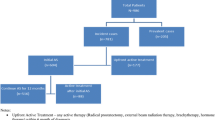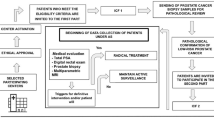Abstract
Introduction
Active surveillance (AS) is a management strategy for addressing the widely acknowledged problem of over diagnosis and over treatment of clinically indolent prostate cancer.
Methods
A total of 80 patients were enrolled on the AS program in our institution between January 2008 and June 2012. All data were collected prospectively in a secure database.
Results
The mean age of patients enrolled was 62.7 years (range 50–72). Median PSA at enrolment was 5.6 ng/mL (range 1.2–13.4). The mean follow-up was 32 months (range 2–54). In total, 85 % of patients had a repeat biopsy after 1-year with 30 % having another biopsy after 3 years. Overall, 45 % of patients remain on AS. In the remainder; 42.5 % of patients have been removed from AS for definitive treatment, while 8.75 % of patients are now on watchful waiting, 2.5 % of patients self discharged from the program and one patient died of cardiovascular disease. The prostate cancer specific survival rate is 100 %. Reasons for removal from AS and referral for treatment were; 67.6 % of patients had upgrade of disease on repeat biopsy, 17.6 % of patients had PSA progression, 11.8 % patients had progression of disease on MRI, and one patient developed a palpable nodule. Regarding definitive treatment; 52.9 % of patients have been for referred for external beam radiotherapy, 14.7 % have been referred for brachytherapy, 29.4 % have been referred for surgery and one patient has refused definitive treatment.
Conclusion
Our findings to date support active surveillance as a valid strategy for early, localised prostate cancer.



Similar content being viewed by others
References
Center MM, Jemal A, Lortet-Tieulent J et al (2012) International variation in prostate cancer incidence and mortality rates. Eur Urol 61:1079–1092
Ferlay J, Shin HR, Bray F, Forman D, Mathers C, Parkin DM (2010) Estimates of worldwide burden of cancer in 2008: GLOBOCAN 2008. Int J Can 15(127):2893–2917
Prostate cancer UK––Incidence statistics. 2011 [cited; Available from: http://info.cancerresearchuk.org/cancerstats/types/prostate/incidence/]
National Cancer Registry of Ireland––Recent trends in prostate cancer. 2010 [cited; Available from: http://www.ncri.ie/pubs/pubfiles/prostate%20trends.pdf]
Bono AV (2004) The global state of prostate cancer: epidemiology and screening in the second millennium. BJU Int 94(Suppl 3):1–2
Schroder FH, Hugosson J, Roobol MJ et al (2009) Screening and prostate-cancer mortality in a randomized european study. N Engl J Med 26(360):1320–1328
Wilt TJ, Brawer MK, Jones KM et al (2012) Radical prostatectomy versus observation for localized prostate cancer. N Engl J Med 19(367):203–213
D’Amico AV (2011) Risk-based management of prostate cancer. N Engl J Med 14(365):169–171
D’Amico AV, Moul J, Carroll PR, Sun L, Lubeck D, Chen MH (2003) Cancer-specific mortality after surgery or radiation for patients with clinically localized prostate cancer managed during the prostate-specific antigen era. J Clin Oncol 1(21):2163–2172
Boorjian SA, Karnes RJ, Rangel LJ, Bergstralh EJ, Blute ML (2008) Mayo Clinic validation of the D’amico risk group classification for predicting survival following radical prostatectomy. J Urol 179:1354–1360 discussion 60–1
Epstein JI, Walsh PC, Carmichael M, Brendler CB (1994) Pathologic and clinical findings to predict tumor extent of non-palpable (stage T1c) prostate cancer. JAMA 2(271):368–374
Bastian PJ, Mangold LA, Epstein JI, Partin AW (2004) Characteristics of insignificant clinical T1c prostate tumors. A contemporary analysis. Cancer 1(101):2001–2005
Choo R, Klotz L, Danjoux C et al (2002) Feasibility study: watchful waiting for localized low to intermediate grade prostate carcinoma with selective delayed intervention based on prostate specific antigen, histological and/or clinical progression. J Urol 167:1664–1669
Moore CM, Ridout A, Emberton M (2013) The role of MRI in active surveillance of prostate cancer. Curr Opin Urol 23(3):261–267
Dall’Era MA, Albertsen PC, Bangma C et al (2012) Active surveillance for prostate cancer: a systematic review of the literature. Eur Urol 62:976–983
Oken MM, Creech RH, Tormey DC et al (1982) Toxicity and response criteria of the eastern cooperative oncology group. Am J Clin Oncol 5:649–655
Forde JC, Marignol L, Blake O et al (2012) Standardization of assay methods reduces variability of total PSA measurements: an Irish study. BJU Int 110:644–650
Heidenreich A, Bellmunt J, Bolla M et al (2011) EAU guidelines on prostate cancer. Part I: screening, diagnosis, and treatment of clinically localised disease. Actas Urol Esp 35:501–514
Thompson I, Thrasher JB, Aus G et al (2007) Guideline for the management of clinically localized prostate cancer: 2007 update. J Urol 177:2106–2131
Adamy A, Yee DS, Matsushita K et al (2011) Role of prostate specific antigen and immediate confirmatory biopsy in predicting progression during active surveillance for low risk prostate cancer. J Urol 185:477–482
Berglund RK, Masterson TA, Vora KC, Eggener SE, Eastham JA, Guillonneau BD (2008) Pathological upgrading and up staging with immediate repeat biopsy in patients eligible for active surveillance. J Urol 180:1964–1967 discussion 7–8
Soloway MS MM, Rosenberg D, Kava B (2011) Active surveillance for prostate cancer: an update of the Miami experience [abstract]. 31st Congress of the Societe Internationale D’Urologie. Berlin, Germany
Soloway MS, Soloway CT, Eldefrawy A, Acosta K, Kava B, Manoharan M (2010) Careful selection and close monitoring of low-risk prostate cancer patients on active surveillance minimizes the need for treatment. Eur Urol 58:831–835
Klotz L, Zhang L, Lam A, Nam R, Mamedov A, Loblaw A (2010) Clinical results of long-term follow-up of a large, active surveillance cohort with localized prostate cancer. J Clin Oncol 1(28):126–131
Krakowsky Y, Loblaw A, Klotz L (2010) Prostate cancer death of men treated with initial active surveillance: clinical and biochemical characteristics. J Urol 184:131–135
van den Bergh RC, Roemeling S, Roobol MJ et al (2009) Outcomes of men with screen-detected prostate cancer eligible for active surveillance who were managed expectantly. Eur Urol 55:1–8
Tosoian JJ, Trock BJ, Landis P et al (2011) Active surveillance program for prostate cancer: an update of the johns hopkins experience. J Clin Oncol 1(29):2185–2190
Ayres BE, Montgomery BS, Barber NJ et al (2012) The role of transperineal template prostate biopsies in restaging men with prostate cancer managed by active surveillance. BJU Int 109:1170–1176
van As NJ, Norman AR, Thomas K et al (2008) Predicting the probability of deferred radical treatment for localised prostate cancer managed by active surveillance. Eur Urol 54:1297–1305
Duffield AS, Lee TK, Miyamoto H, Carter HB, Epstein JI (2009) Radical prostatectomy findings in patients in whom active surveillance of prostate cancer fails. J Urol 182:2274–2278
NICE (2008) Prostate Cancer: Diagnosis and Treatment. [cited; Available from: http://www.nice.org.uk/nicemedia/pdf/CG58NICEGuideline.pdf
Lawrentschuk N, Klotz L (2011) Active surveillance for low-risk prostate cancer: an update. Nat Rev Urol 8:312–320
Turkbey B, Mani H, Shah V et al (2011) Multi-parametric 3T prostate magnetic resonance imaging to detect cancer: histopathological correlation using prostatectomy specimens processed in customized magnetic resonance imaging based molds. J Urol 186:1818–1824
Morgan VA, Riches SF, Thomas K et al (2011) Diffusion-weighted magnetic resonance imaging for monitoring prostate cancer progression in patients managed by active surveillance. Br J Radiol 84:31–37
Giles SL, Morgan VA, Riches SF, Thomas K, Parker C, deSouza NM (2011) Apparent diffusion coefficient as a predictive biomarker of prostate cancer progression: value of fast and slow diffusion components. AJR Am J Roentgenol 196:586–591
Mullins JK, Bonekamp D, Landis P et al (2013) Multi-parametric magnetic resonance imaging findings in men with low-risk prostate cancer followed using active surveillance. BJU Int 111(7):1037–1045
Author information
Authors and Affiliations
Corresponding author
Rights and permissions
About this article
Cite this article
Forde, J.C., Daly, P.J., White, S. et al. A single centre experience of active surveillance as management strategy for low-risk prostate cancer in Ireland. Ir J Med Sci 183, 377–382 (2014). https://doi.org/10.1007/s11845-013-1024-9
Received:
Accepted:
Published:
Issue Date:
DOI: https://doi.org/10.1007/s11845-013-1024-9




